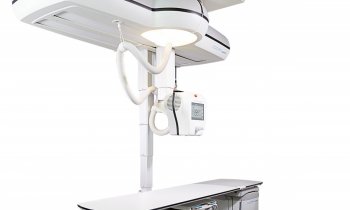Working with Toshiba’s Aplio 500
In August, Bill Smith, Head of Ultrasound Services at privately-owned Clinical Diagnostic Services in London,UK, was particularly excited about advances in elastography and Fly Thru in Toshiba’s newly launched high-end ultrasound series Aplio 300, 400 and 500. Discussing initial experiences utilising the system, he said, ‘Fly Thru is opening up completely new perspectives for noninvasive imaging diagnostics in the Ob/Gyn ultrasound lab. It potentially offers the possibility to replace endoscopic examinations and might well yield better results because the surrounding tissue can also be seen at the same time.’ Work is ongoing at his clinic to evaluate the technology. European Hospital asked him for an update.

Results from work at the London clinic are very exciting, said Bill Smith. However, he added: ‘I think from a technical point of view we can only take it so far. What we must now do is put it into a major clinical programme, for instance a series of saline infusions with the Fly Thru technology, and then compare them with the hysteroscopic findings. That’s the meat on the bone – it would be essential in order to attract clinicians to this kind of technology. They want to see it working in clinical practice. So, we are waiting to start a couple of clinical programmes. It’s still early days for elastography, before we highlight a number of areas where it is useful. ‘We’d regard elastography as a single modality in terms of ultrasound scanning – it’s part of our routine scanning, but just a single component. It adds a little bit more in terms of diagnostic competence and capability. But, it is very important. We are still working and gaining experience and remain excited about the technology.’
Does elastography really add information?
‘Without a doubt – breast work has shown its diagnostic value. We also have cases where it certainly adds to our diagnostic confidence in terms of transvaginal scanning. A particularly useful application involves identifying the likely presence of adenomyosis. We find that elastography is very, very useful, and we do get characteristic changes that we associate with patients who appear to have extensive adenomyosis. ‘That’s not the only use for elastography. We’re lthe endometrium during a natural cycle. Obviously these investigations are carried out without any kind of invasive measure that would destroy or damage the endometrium.
So, colour Doppler, good 2-D greyscale, 3-D, elastography, together are all very, very helpful when trying to assess endometrial development and associated abnormalities. ‘I’m sure, as we start looking at other areas, we’ll also find additional benefits. Ovarian lesions are probably the next step, but we remain excited about the potential of both the Fly Thru and elastography. ‘From the Aplio 500 point of view, I don’t think anyone can sell a major system purely on the basis of Fly Thru and elastography. You have to show that a system is still a really very high-ranking in terms ofooking, for example, at endometrial receptivity and trying to get more information in terms of normal tissue changes within the conventional 2-D greyscale, so we’re busy working with Toshiba trying to perfect the 2-D greyscale, particularly with the transvaginal transducer.
Are the greyscale images not what you expected?
‘They are very good but have not yet reached the level we feel the system is capable of producing.I have no doubt that, with a very positive and talented team around you, you’d be able to achieve those levels. We are working very closely with the Toshiba colleagues in Japan, who’ve been extremely helpful and it’s very enjoyable working with them. ‘The bottom line is that the potential is there. Ultimately, we must offer our patients what’s best. The Toshiba system has further potential, besides the fact that it’s already a good machine. It provides high levels of diagnostic capability, in all senses, whether it’s 2-D greyscale, transabdominal and transvaginal, colour Doppler, elastography, 3-D or Fly Thru – we are really very pleased with the machine – but we still feel it’s very capable of producing even better levels of ultrasound imaging. ‘It’s like a great car, but we just want to fine tune it, which is why working with an engineer is important. Unfortunately, people in the UK don’t work with engineers or physicists any more – they appear to have a reduced role in ultrasound now, which is detrimental to its development and getting the best from ultrasound machines. Modern ultrasound systems are now very complex creatures needing that technical back-up and support.
18.11.2011











